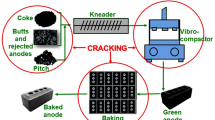Abstract
Copper electrorefining tests were conducted in a pilot-scale cell under commercial tankhouse environment to study the effects of anode compositions, current density, cathode blank width, and flow rate on anode slime behavior and cathode copper purity. Three different types of anodes (high, mid, and low impurity levels) were used in the tests and were analyzed under SEM/EDS. The harvested copper cathodes were weighed and analyzed for impurities concentrations using DC Arc. The adhered slimes and released slimes were collected, weighed, and analyzed for compositions using ICP. It was shown that the lead-to-arsenic ratio in the anodes affects the sintering and coalescence of slime particles. High current density condition can improve anode slime adhesion and cathode purity by intensifying slime particles’ coalescence and dissolving part of the particles. Wide cathode blanks can raise the anodic current densities significantly and result in massive release of large slime particle aggregates, which are not likely to contaminate the cathode copper. Low flow rate can cause anode passivation and increase local temperatures in front of the anode, which leads to very intense sintering and coalescence of slime particles. The results and analyses of the tests present potential solutions for industrial copper electrorefining process.














Similar content being viewed by others
References
Michael L. Free: Hydrometallurgy: Fundamentals and Applications, John Wiley & Sons, Inc., Hoboken, NJ, 2013, pp. 229-232.
W. Zeng, M. L. Free, and S. Wang: J. Electrochem. Soc., 2016, vol. 163, pp. E14-E31.
W. Zeng, J. Werner, and M. L. Free: Hydrometallurgy, 2015, vol. 156, pp. 232-238.
W. Zeng, M. L. Free, J. Werner, and S. Wang: J. Electrochem. Soc., 2015, vol. 162, pp. E338-E352.
W. Zeng, S. Wang, M. L. Free: J. Electrochem. Soc., 2016, vol. 163, pp. E111-E122.
T. T. Chen and J. E. Dutrizac: JOM, 1990, vol. 42, pp. 39-44.
T. T. Chen and J. E. Dutrizac: Can. Metall. Q., 1988, vol. 27, pp. 91-96.
T. T. Chen and J. E. Dutrizac: Can. Metall. Q., 1990, vol. 29, pp. 27-37.
T. T. Chen and J. E. Dutrizac: Can. Metall. Q., 1989, vol. 28, pp. 127-134.
T. T. Chen and J. E. Dutrizac: Can. Metall. Q., 1991, vol. 30, pp. 95-106.
T. T. Chen and J. E. Dutrizac: Metall. Mater. Trans. B, 2005, vol. 36, pp. 229-240.
T. T. Chen and J. E. Dutrizac: Can. Metall. Q., 1988, vol. 27, pp. 97-105.
J. D. Scott: Metall. Trans. B, 1990, vol. 21, pp. 629-635.
T. T. Chen and J. E. Dutrizac: Metall. Trans. B, 1989, vol. 20, pp. 345-361.
X. Cheng and J. B. Hiskey: Metall. Mater. Trans. B, 1996, vol. 27, pp. 610-616.
J. B. Hiskey: TT Chen Honorary Symposium on Hydrometallurgy, Electrometallurgy and Materials Characterization, TMS, John Wiley & Sons, Inc., Hoboken, NJ, 2012, pp. 101-112.
X. Wang, Q. Chen, Z. Yin, M. Wang, B. Xiao, and F. Zhang: Hydrometallurgy, 2011, vol. 105, pp. 355-358.
F. X. Xiao, Y. J. Zheng, Y. Wang, W. Xu, C. H. Li, and H. S. Jian: Trans. Nonferrous Met. Soc. China, 2007, vol. 15, pp. 1069-1074.
S. Wang, D. Kim, and M. Moats: Proceedings of Copper 2013, vol. 5, pp. 577-594.
M. Moats, S. Wang, and D. Kim: TT Chen Honorary Symposium on Hydrometallurgy, Electrometallurgy and Materials Characterization, TMS, John Wiley & Sons, Inc., Hoboken, NJ, 2012, pp. 3-21.
C. A. Moller and B. Friedrich: Proceedings of Copper 2010, vol. 4, pp. 1495-1510.
J. E. Hoffmann: JOM, 2004, vol. 56, pp. 30-33.
S. Wang: JOM, 2004, vol. 56, pp. 34-37.
Michael L. Free: Hydrometallurgy: Fundamentals and Applications, John Wiley & Sons, Inc., Hoboken, NJ, 2013, pp. 218-228.
Author information
Authors and Affiliations
Corresponding author
Additional information
Manuscript submitted April 1, 2016.
Rights and permissions
About this article
Cite this article
Zeng, W., Wang, S. & Free, M.L. Experimental Studies of the Effects of Anode Composition and Process Parameters on Anode Slime Adhesion and Cathode Copper Purity by Performing Copper Electrorefining in a Pilot-Scale Cell. Metall Mater Trans B 47, 3178–3191 (2016). https://doi.org/10.1007/s11663-016-0736-4
Published:
Issue Date:
DOI: https://doi.org/10.1007/s11663-016-0736-4




